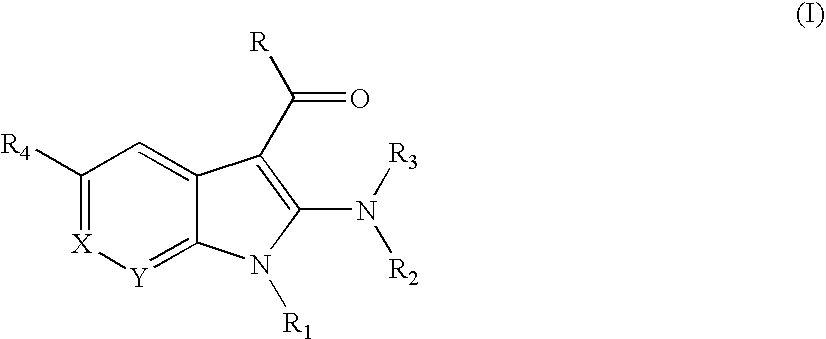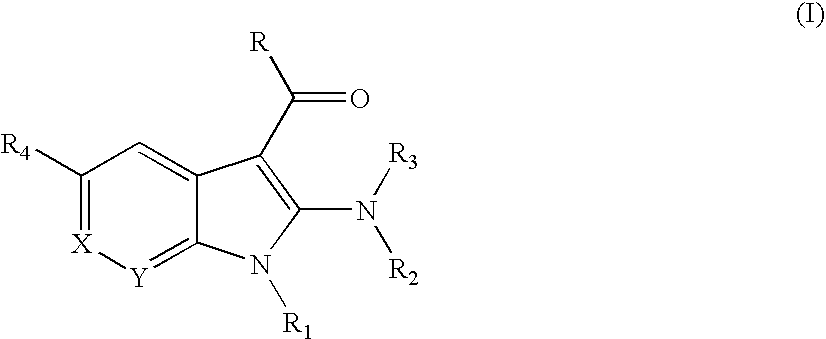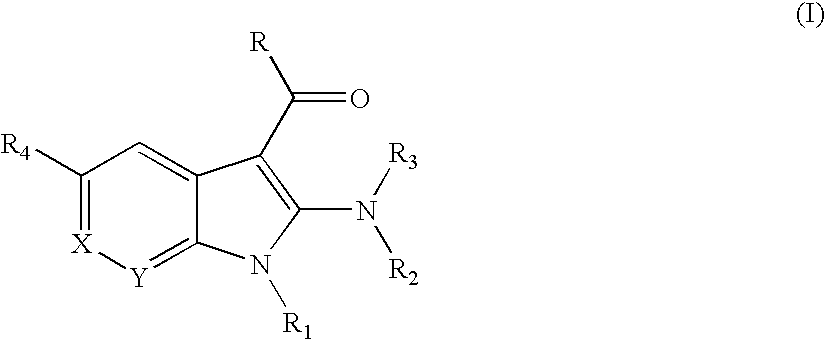Substituted indoles as inhibitors of poly (ADP-ribose) polymerase (PARP)
a technology of poly (adp-ribose) polymerase and substituted indoles, which is applied in the field of substituting indole derivatives, can solve problems such as uncontrolled activation of parp
- Summary
- Abstract
- Description
- Claims
- Application Information
AI Technical Summary
Benefits of technology
Problems solved by technology
Method used
Image
Examples
examples
General
Reactions generally are run under a nitrogen atmosphere. Solvents are dried over magnesium sulfate and are evaporated under vacuum on a rotary evaporator. TLC analyses are performed with EM Science silica gel 60 F254 plates with visualization by UV irradiation. Flash chromatography is performed using Alltech prepacked silica gel cartridges. The 1H NMR spectra are run at 300 MHz on a Gemini 300 or Varian VXR 300 spectrometer and are determined in a deuterated solvent, such as DMSO-D6 or CDCl3 unless otherwise noted. Chemical shifts values are indicated in parts per million (ppm) with reference to tetramethylsilane (TMS) as the internal standard. The LC / MS are run on a Micromass Platform LCZ.
As used in the examples and preparations that follow, the terms used therein shall have the meanings indicated: “kg” refers to kilograms, “g” refers to grams, “mg” refers to milligrams, “μg” refers to micrograms, “pg” refers to picograms, “lb” refers to pounds, “oz” refers to ounces, “m...
preparation 1
1-Phenyl-1H-indol-2-one
The title compound is prepared in accordance with the procedures described in Latrell, Bartmann, Granzier DE 2 707 268 (1978) as follows. A solution of diphenylamine (40 g, 237 mmol) and triethylamine (66.1 mL, 474 mmol) in toluene (65 mL) is added dropwise to a solution of chloroacetyl chloride (20.7 mL, 260 mmol) in toluene (40 mL) while cooling in an ice-water bath. The cold bath is removed and the reaction mixture is heated at 55-65° C. for 3 hr. The cooled reaction mixture is diluted with toluene (100 mL), filtered and the filtrate concentrated to give 2-chloro-N,N-diphenylacetamide (24.4 g, 42% yield) as a light brown solid. NMR (CDCl3) 7.56-7.19 (10H, m), 4.01 (2H, s).
Aluminum chloride (8.0 g, 60 mmol) is added in two portions to a solution of the above amide (5.0 g, 20.4 mmol) in 1,2-dichlorobenzene (10 mL). The reaction mixture is heated at reflux for 30 min, cooled slightly, poured onto ice (100 g) and the resulting solids are collected by filtra...
preparation 2
2-Chloro-1-phenyl-1H-indole-3-carboxaldehyde
The title compound can be synthesized in accordance with the procedures described in Andreani, A.; Bonazzi, D. et al. J. Med. Chem. 20, 1344-1346, 1977; Latrell, Bartmann, Granzier DE 2 707 268 (1978) or in accordance with the procedures set forth below.
Phosphorous oxychloride (50 mL, 538 mmol) is added slowly to a solution of DMF (50 mL) in dichloromethane (50 mL) maintaining the temperature at 5° C. After 30 min, a solution of 1-phenyl-1H-indol-2-one (25 g, 120 mmol) and pyridine (25 mL, 309 mmol) in chloroform (125 mL) is added and the reaction is stirred 48 hr at room temperature. The reaction is poured into ice water (600 mL) and the aqueous layer is separated and extracted with chloroform (3×200 mL). The combined organic layer and extracts is dried, filtered and concentrated. The solid residue is crystallized from ethanol to afford 2-chloro-1-phenyl-1H-indole-3-carboxaldehyde (12.0 g, 39.25% yield) as an orange solid. NMR (CDCl3)...
PUM
| Property | Measurement | Unit |
|---|---|---|
| Toxicity | aaaaa | aaaaa |
Abstract
Description
Claims
Application Information
 Login to View More
Login to View More - R&D
- Intellectual Property
- Life Sciences
- Materials
- Tech Scout
- Unparalleled Data Quality
- Higher Quality Content
- 60% Fewer Hallucinations
Browse by: Latest US Patents, China's latest patents, Technical Efficacy Thesaurus, Application Domain, Technology Topic, Popular Technical Reports.
© 2025 PatSnap. All rights reserved.Legal|Privacy policy|Modern Slavery Act Transparency Statement|Sitemap|About US| Contact US: help@patsnap.com



